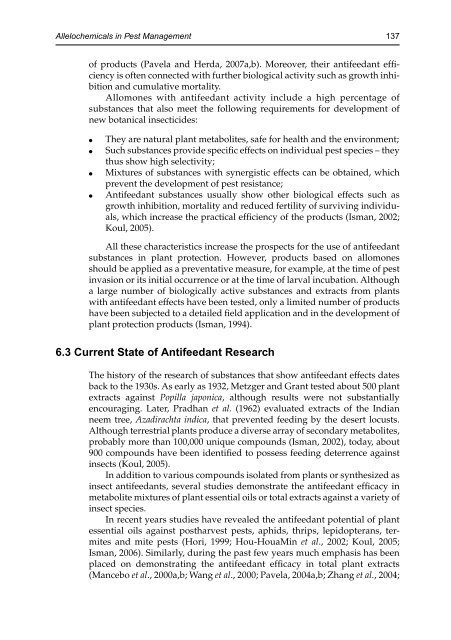natural-products-in-plant-pest-management
natural-products-in-plant-pest-management
natural-products-in-plant-pest-management
Create successful ePaper yourself
Turn your PDF publications into a flip-book with our unique Google optimized e-Paper software.
Allelochemicals <strong>in</strong> Pest Management 137of <strong>products</strong> (Pavela and Herda, 2007a,b). Moreover, their antifeedant efficiencyis often connected with further biological activity such as growth <strong>in</strong>hibitionand cumulative mortality.Allomones with antifeedant activity <strong>in</strong>clude a high percentage ofsubstances that also meet the follow<strong>in</strong>g requirements for development ofnew botanical <strong>in</strong>secticides:●●●●They are <strong>natural</strong> <strong>plant</strong> metabolites, safe for health and the environment;Such substances provide specific effects on <strong>in</strong>dividual <strong>pest</strong> species – theythus show high selectivity;Mixtures of substances with synergistic effects can be obta<strong>in</strong>ed, whichprevent the development of <strong>pest</strong> resistance;Antifeedant substances usually show other biological effects such asgrowth <strong>in</strong>hibition, mortality and reduced fertility of surviv<strong>in</strong>g <strong>in</strong>dividuals,which <strong>in</strong>crease the practical efficiency of the <strong>products</strong> (Isman, 2002;Koul, 2005).All these characteristics <strong>in</strong>crease the prospects for the use of antifeedantsubstances <strong>in</strong> <strong>plant</strong> protection. However, <strong>products</strong> based on allomonesshould be applied as a preventative measure, for example, at the time of <strong>pest</strong><strong>in</strong>vasion or its <strong>in</strong>itial occurrence or at the time of larval <strong>in</strong>cubation. Althougha large number of biologically active substances and extracts from <strong>plant</strong>swith antifeedant effects have been tested, only a limited number of <strong>products</strong>have been subjected to a detailed field application and <strong>in</strong> the development of<strong>plant</strong> protection <strong>products</strong> (Isman, 1994).6.3 Current State of Antifeedant ResearchThe history of the research of substances that show antifeedant effects datesback to the 1930s. As early as 1932, Metzger and Grant tested about 500 <strong>plant</strong>extracts aga<strong>in</strong>st Popilla japonica, although results were not substantiallyencourag<strong>in</strong>g. Later, Pradhan et al. (1962) evaluated extracts of the Indianneem tree, Azadirachta <strong>in</strong>dica, that prevented feed<strong>in</strong>g by the desert locusts.Although terrestrial <strong>plant</strong>s produce a diverse array of secondary metabolites,probably more than 100,000 unique compounds (Isman, 2002), today, about900 compounds have been identified to possess feed<strong>in</strong>g deterrence aga<strong>in</strong>st<strong>in</strong>sects (Koul, 2005).In addition to various compounds isolated from <strong>plant</strong>s or synthesized as<strong>in</strong>sect antifeedants, several studies demonstrate the antifeedant efficacy <strong>in</strong>metabolite mixtures of <strong>plant</strong> essential oils or total extracts aga<strong>in</strong>st a variety of<strong>in</strong>sect species.In recent years studies have revealed the antifeedant potential of <strong>plant</strong>essential oils aga<strong>in</strong>st postharvest <strong>pest</strong>s, aphids, thrips, lepidopterans, termitesand mite <strong>pest</strong>s (Hori, 1999; Hou-HouaM<strong>in</strong> et al., 2002; Koul, 2005;Isman, 2006). Similarly, dur<strong>in</strong>g the past few years much emphasis has beenplaced on demonstrat<strong>in</strong>g the antifeedant efficacy <strong>in</strong> total <strong>plant</strong> extracts(Mancebo et al., 2000a,b; Wang et al., 2000; Pavela, 2004a,b; Zhang et al., 2004;


